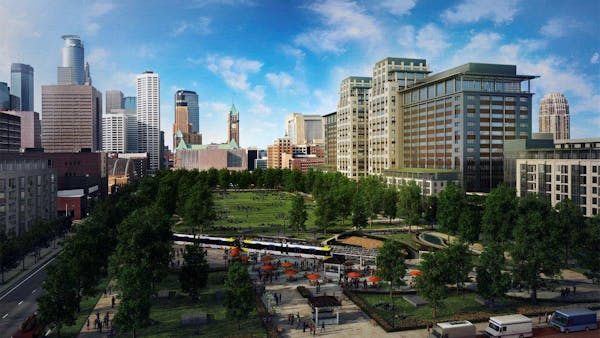Minneapolis Mayor R.T. Rybak and the City Council were all smiles Tuesday when the Ryan Cos. announced a multi-block mixed-used development adjacent to the new Minnesota Vikings stadium.
There was even a joke that it took exactly one day for new ancillary development to come to fruition after the design for the stadium was first unveiled Monday.
Can't begrudge Minneapolis political leaders for claiming a little credit for their stadium support, but only if it's a little. A project like this at that site, with nearly 1.2 million square feet of offices and more than 300 units of housing, wasn't a day in the making. More like 30 years.
The new project isn't just the result of a new stadium, either. This privately financed project wouldn't be possible without the cumulative effect of hundreds of millions dollars of past public and private investments in the area around the site, from light-rail transit to the Guthrie Theater a few blocks away.
In fact the stadium itself might not be as important to the economics of the project as proposed new parking ramps that came with the stadium deal.
If it weren't for those things, it could be 1982 all over again. Those with long enough memories will remember what followed the opening the Metrodome that year.
When it came to new development, mostly nothing.
In front of the Metrodome were acres of surface parking. Except for a hole in the ground or possibly a vacant building, nothing is worse for the life of the city than a cracked asphalt lot to hold cars.
Behind the stadium site was a freeway and a series of freeway ramps. The central business district was a long way away, and a few blocks away on the river were the remains of the all-but-dead milling industry.
A massive football stadium doesn't appear to be a very appealing neighbor either. Most days it's just a big empty building with hardly a soul around.
But if you live nearby, those are the good days. On NFL game days, it's total chaos in your neighborhood.
If the Metrodome was mostly an island surrounded by not much else, however, there was plenty happening elsewhere in the city that gradually made the area around the stadium more attractive.
It took millions of dollars and many years, but the Washburn A Mill eventually became the home of the Mill City Museum. Out back of the museum on the Mississippi River is the Stone Arch Bridge, renovated and opened to pedestrians in 1994.
A big step forward was taken in the late 1990s when the development firm CSM Corp. took on the restoration of the Milwaukee Road Depot, which had stood vacant since 1971.
The new Guthrie, partly funded through the state of Minnesota's 2003 bonding bill, opened on the riverfront in 2006.
Activity along the river included lots of privately financed condominiums along with restaurants and offices, but the single most important investment may have been the dollars that went into transit. The Hiawatha light-rail line has been dropping off fans in the front of the football stadium since the 2004 season.
One could argue that the riverfront and the Milwaukee Road Depot are not really in the stadium's Downtown East neighborhood, but it's about a nine-minute walk to the lobby of the Guthrie Theater from the street in front of the proposed Ryan office and apartment buildings. It's about a 15-minute walk to the lobby of the IDS Center, long considered the heart of the central business district.
The land Ryan would develop would be acquired from the Star Tribune, and while it's an improving site it's not a great one. It still feels like the back side of downtown.
Standing at the corner of Portland Avenue and S. 4th Street and looking toward the downtown, there is a virtual four-block wall on 5th Avenue S. that consists of a parking ramp, the county jail, a parking ramp and another parking ramp.
There are clear positives to the site, though, including having five blocks controlled by one owner. Then there is the stadium's own parking ramp needs, a key to making this project work.
As described by the mayor at the news conference, part of the agreement between the Vikings in the state financing deal was a provision calling for parking for 2,000 cars near the stadium. Clearly it's enormously costly to build a parking deck to be used just 10 days a year, but what if more than 5,000 office workers were a block away? They couldn't all take light rail to work.
If all goes as planned, the city will issue bonds for ramp construction, with debt service paid by parking revenue from office workers parking there for work and football fans on fall weekends. Parking revenue would also help fund debt service on bonds to acquire and create the Yard, a two-block park that would be in front of its buildings and extend from the plaza in front of the stadium.
In addition to its plan to finance the office, residential and retail buildings privately, Ryan proposes to backstop the first 10 years of debt service on the bonds.
This may really be one of those rare big redevelopment projects in which the taxpayers' checkbook stays in the drawer. But think of it as a chance to realize some additional returns on many past investments made in the city.
lee.schafer@startribune.com • 612-673-4302

Schafer: What do you really need to retire?

Schafer: How doing business can be a bit more like Christmas morning

Schafer: There won't soon be another opportunity to rethink the I-94 corridor

Schafer: The fruits of Honeywell's long-game dedication to quantum computer now being seen


